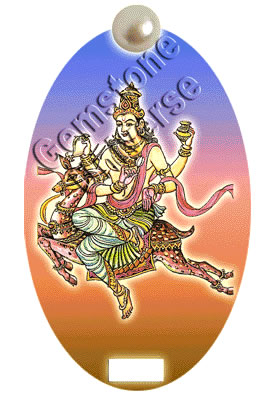Natural Pearl/ Nacre - The Jyotish Gemstone of the Serene Moon
According to Jataka Parijaata the jyotish gemstone, gem of the Moon is the natural pearl Pearl. Like the Moon which exudes cool pleasing rays, the Natural Pearl too ensures peace of mind and contentment. Pearls are treasures from the Earth’s streams, rivers, lakes, seas, and oceans, and they have always embodied the mystery, power, and life-like sustaining nature of water.
The Moon is feminine, imaginative, receptive, sensitive, intuitive and subject to change. It acts as a large crystalline transformer, converting solar energy which reflects to the planet Earth. The Moon rules over our psyche, which is represented by the deer on which he rides. In one hand he is holding the disc (charka) of Vishnu to remove obstacles, and in another hand a conch (Symbol of primordial sound) whose sound leads to liberation from the cycle of birth and rebirth. In his third hand he holds a lotus of purity and in his fourth hand the reins of the deer.
Moon is the presiding deity of the element water, and rules over the tides of the sea. The sphere of the Moon is the reservoir of rainwater and thus Moon is the ruler of plants and vegetable kingdom. Moon represents the mother or female principle, the energy that creates and preserves.
Moon represents the mother or female principle, the energy that creates and preserves.
Get your Gemstone consultation done here
Different Names of Natural Pearl
The Pearl is known by many names, such as, Mukta, Muktaphal, Shuktija, Bhouktika, Shashiratna, Chandraratna, and Shashipriya. In Urdu it is known as Mukharid, and in Latin it is called Margarita.
Buy a Natural, Sattvik Pearl Gemstone
Formation of a Natural Pearl
Formation of a pearl inside an oyster is thought to occur because of foreign material inside the body of the oyster. To save itself from the undesired material the mollusk coats the object with layers of nacre. It takes many years for a mollusk to produce a pearl of substantial size. The process through which the pearls are formed inside the body of the mollusk is very delicate, and a little disturbance at any stage of development of a pearl can influence its shape and luster. The finest pearl is that which has no foreign matter in its core. There is a common belief that when Swati Nakshatra rain comes to earth it produces pearl in pearl oysters. The mollusk is then said to open its mouth to receive the first raindrops. The pearls thus produced by the raindrops of Swati Nakshatra are the finest and have no foreign matter in them.
Pearl Classification according to various esoteric texts
There are eight kinds of pearls from eight different sources. They are:
- Sky Pearl, known in Sanskrit as Megh-mukta and Akash mukta : It is said that when it rains under the influence of Pushya or Shravan Nakshatraon a Sunday or Monday, this Pearl comes to earth with raindrops.
- Cobra Pearl, known as Sarp-mukta or Sarp-mani : This pearl also develops in the cobra hood of a king cobra when raindrops influenced by Swati Nakshatra falling into the mouth of the king Cobra.
- Bamboo Pearl, known as Bansh mukta : It is of greenish tint and elliptical in form like a berry. Its birth in bamboo is related to the rain of the Swati Nakshatra.
- Hog Pearl, also known as Shookar mukta : Hog pearl is found in the head of a hog. It is quite large, round and mustard yellow.
- Elephantine Pearl, known as Gaj mukta : The pearl originates in the temple of the elephants of Airawat breed, which is born under the influence of Pushya or Shravan Nakshatra on a Monday or Sunday. The size of the pearl is almost equal to the size of an amla fruit. It is round in shape, of moonlike hue, and is less lustrous than an oyster pearl.
- Conch Pearl, known as Shank mukta : This pearl is also found inside a conch shell. It is oval in shape and as large as an in size. it is found in ochre brown, light yellow, white and light blue shades. Sometimes there are three stripes on it.
- Fish Pearl, also known as Meen Mukta : Nurtured in the stomach or womb of a fish, this pearl is small and yellowish white.
- Oyster Pearl, known as Shukti Mukta : This pearl is formed inside the body of pearl oysters from alternating layers of aragonite and an organic compound, conchiolin. This is also produced by the first raindrop of Swati Nakshatra.
- Australia
- China
- French Polynesia
- India
- Indonesia
- Japan
- Malaysia
- Myanmar
- Philippines
- Thailand
- US

Natural Pearl - Scientific Gemological Data
Hardness & Toughness:
| Hardness | 2 1/2 to 4 on Mohs scale |
| Toughness | Usually good, but variable due to aging, dehydration, and sometimes excessive bleaching during initial processing |
| Specific Gravity | 2.85 to 3.18 |
Stability:
| Environmental Factor | Reaction |
|---|---|
| Heat | Heat can burn cultured pearls or cause discoloration, splitting, or cracking |
| Light | Generally stable, but heat from intense light can cause dehydration and Nacre cracking |
| Chemicals | Attacked by many chemicals and all acids; hair spray, perfume, cosmetics and even acid perspiration can damage Nacre |
Natural Pearl Care and Cleaning:
| Type of Cleaning | Advisability |
|---|---|
| Ultrasonic cleaning | Never |
| Steam cleaning | Never |
| Warm, soapy water | Safe for occasional, through cleaning (if strung, be sure the string is completely dry before wearing) |

